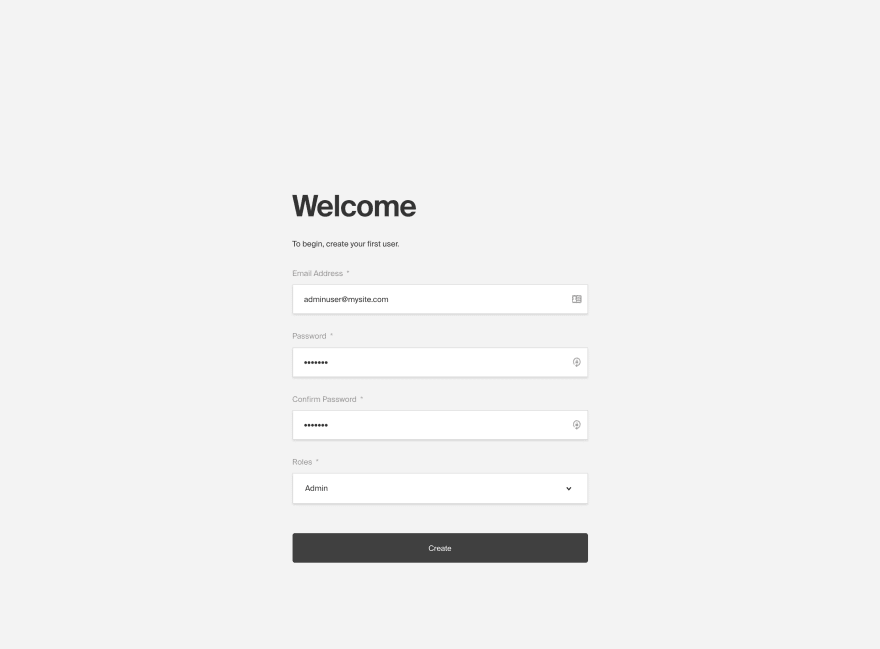42
Build Your Own Role-Based Access Control in Payload
Payload comes with open-ended access control. You can define whatever type of pattern that you can dream up, and best of all—it's all done with simple JavaScript.
A common pattern is Role-Based Access Control. Here, we'll walk you through how to create your own RBAC pattern on both the collection-level and field-level.
In more detail, here are the pieces that we will be building:
- Users collection with
rolefield - Orders collection
- A
beforeChangehook to save which user created the order to acreatedByfield - Access Control functions to restrict Admin Panel access to
adminroles or the creator of the order - admin-only field level access
- A
We'll be using create-payload-app to build out the initial project.
- Run
npx create-payload-app payload-rbac - Select
javascriptfor language - Select
blankfor our template - Follow all other prompts
This will give us a simple project with a Payload config and Users collection. The structure of the project will be:
├─ payload.config.js
└─ collections/
└─ Users.js
└─ Orders.jsFirst, we will add the role field to our Users collection with 2 options: admin and user.
const Users = {
slug: 'users',
auth: true,
admin: {
useAsTitle: 'email',
},
fields: [
{
name: 'role',
type: 'select',
options: [
{ label: 'Admin', value: 'admin' },
{ label: 'User', value: 'user' },
],
required: true,
defaultValue: 'user',
},
],
};
export default Users;Next, we will create a new Orders.js collection in our collections/ directory and scaffold out basic fields and values - including the createdBy relationship to the user.
const Orders = {
slug: 'orders',
fields: [
{
name: 'items',
type: 'array',
fields: [
{
name: 'item',
type: 'text',
}
]
},
{
name: 'createdBy',
type: 'relationship',
relationTo: 'users',
access: {
update: () => false,
},
admin: {
readOnly: true,
position: 'sidebar',
condition: data => Boolean(data?.createdBy)
},
},
]
}
export default Orders;The Orders collection has an array field for items and a createdBy field which is a relationship to our Users collection. The createdBy field will feature a strict update access control function so that it can never be changed.
Notice we also have a condition function under the createdBy field's access. This will hide createdBy until it has a value.
Next, we'll add a hook that will run before any order is created. This is done by adding a beforeChange hook to our collection definition.
const Orders = {
slug: 'orders',
fields: [
// Collapsed
],
hooks: {
beforeChange: [
({ req, operation, data }) => {
if (operation === 'create') {
if (req.user) {
data.createdBy = req.user.id;
return data;
}
}
},
],
},
}The logic in this hook sets the createdBy field to be the current user's id value, only if it is on a create operation. This will create a relationship between an order and the user who created it.
Next, the access control for the collection can be defined. Payload's access control is based on functions. An access control function returns either a boolean value to allow/disallow access or it returns a query constraint that filters the data.
We want our function to handle a few scenarios:
- A user has the 'admin' role - access all orders
- A user created the order - allow access to only those orders
- Any other user - disallow access
const isAdminOrCreatedBy = ({ req: { user } }) => {
// Scenario #1 - Check if user has the 'admin' role
if (user && user.role === 'admin') {
return true;
}
// Scenario #2 - Allow only documents with the current user set to the 'createdBy' field
if (user) {
// Will return access for only documents that were created by the current user
return {
createdBy: {
equals: user.id,
},
};
}
// Scenario #3 - Disallow all others
return false;
};Once defined, this function is added to the access property of the collection definition:
const Orders = {
slug: 'orders',
fields: [
// Collapsed
],
access: {
read: isAdminOrCreatedBy,
update: isAdminOrCreatedBy,
delete: isAdminOrCreatedBy,
},
hooks: {
// Collapsed
},
}With this function added to the read, update, and delete access properties, the function will run whenever these operations are attempted on the collection.
Note: Access functions default to requiring a logged-in user. This is why
createdoes not need to be defined for this example, since we want any logged in user to be able to create an order.
The last step is to add the collection to our payload.config.js
import { buildConfig } from 'payload/config';
import Orders from './collections/Orders';
import Users from './collections/Users';
export default buildConfig({
serverURL: 'http://localhost:3000',
admin: {
user: Users.slug,
},
collections: [
Users,
Orders,
],
});Let's verify the functionality:
Start up the project by running npm run dev or yarn dev and navigate to http://localhost:3000/admin
Create an additional user with the user role by navigating to the Users collection, selecting Create New, entering an email/password, then saving.
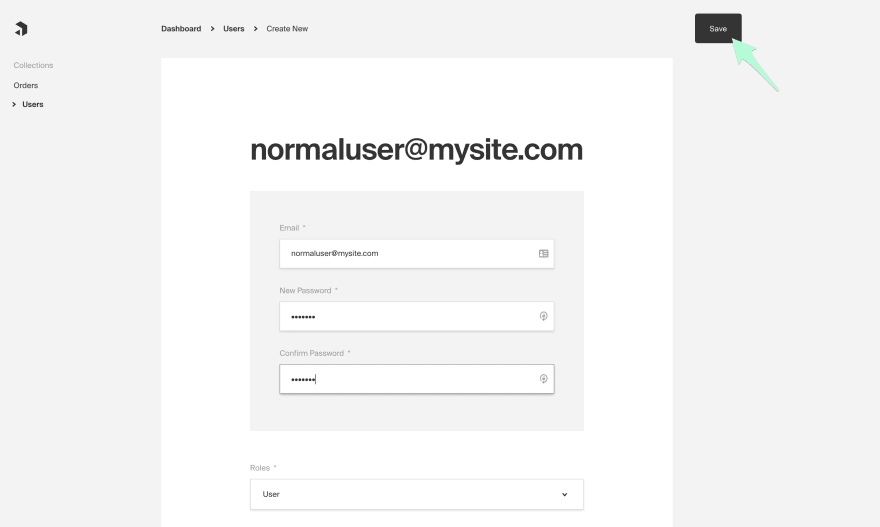

Log out of your admin user by selecting the icon in the bottom left, then log in with the second user.
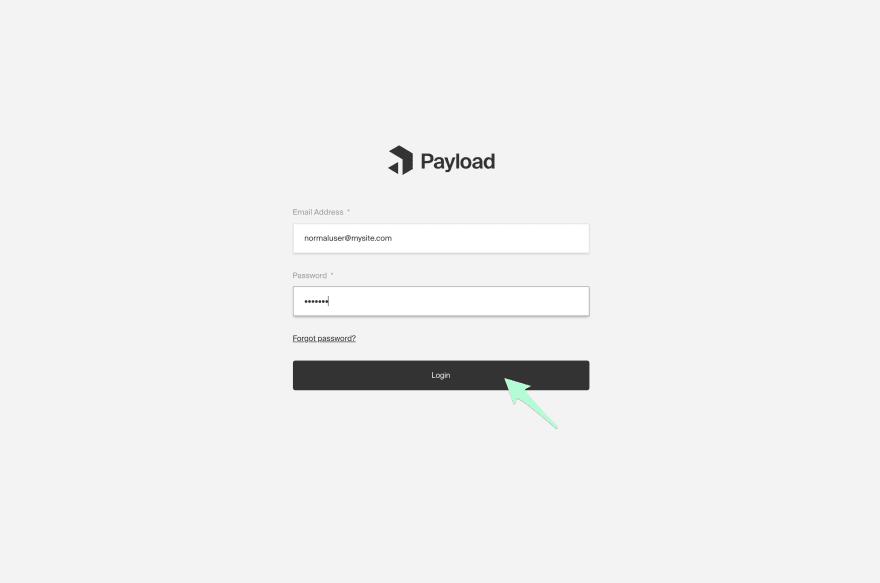
You'll notice if we go to the Orders collection, no Orders will be shown. This indicates that the access control is working properly.
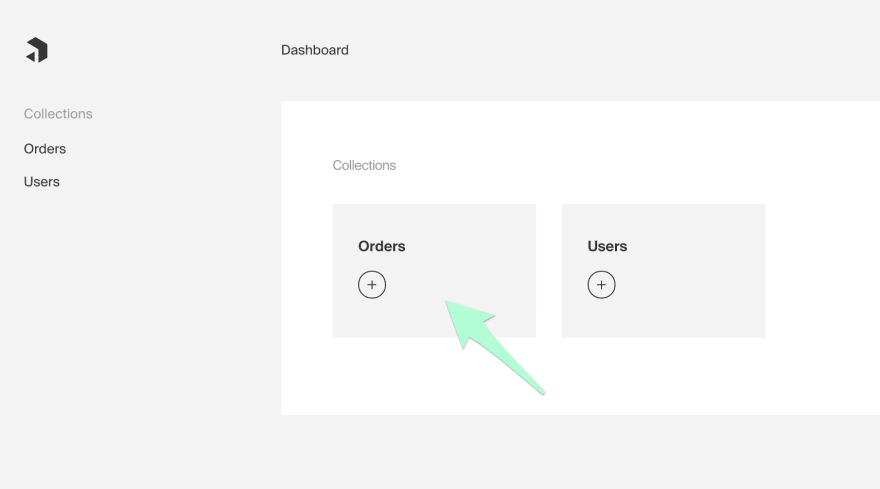
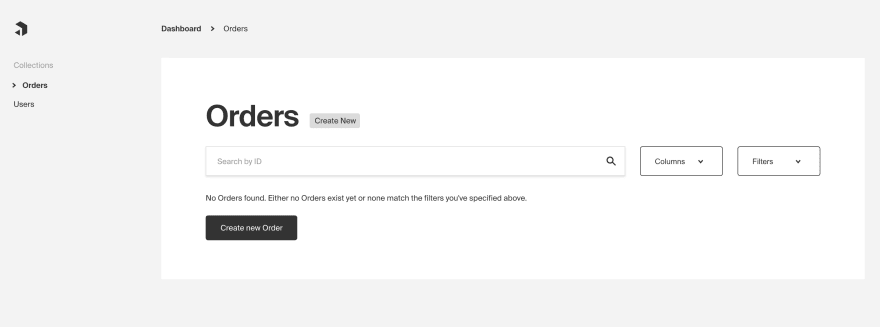
Navigate back to Orders list on the dashboard. There will only be the single order created by the current user.

Log out, then back in with your admin user. You should be able to see the original Order as well as the Order created by the second user.
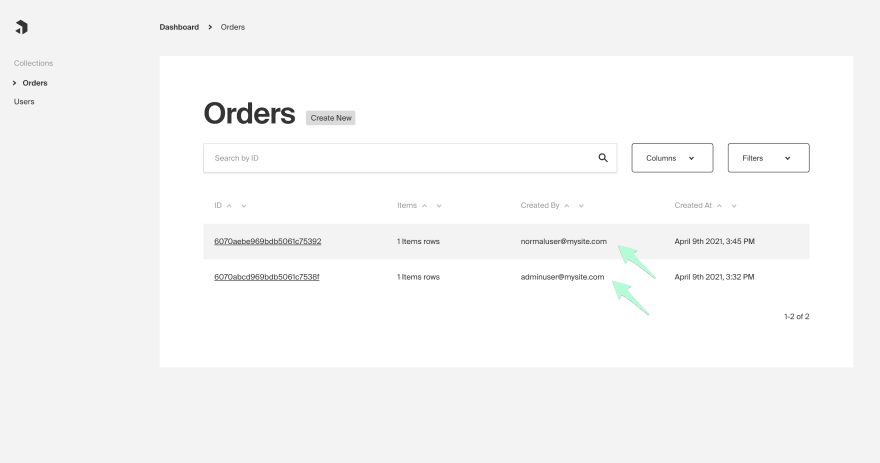
With everything working at the collection level, we can carry the concepts further and see how they can be applied at the field level. Suppose we wanted to add a paymentID field only for Admin users. Create an isAdmin function that checks the role as we did earlier.
const isAdmin = ({ req: { user } }) => (user && user.role === 'admin');Add a new field to Orders and set create, read or update access calls to use the isAdmin function.
const Orders = {
slug: 'orders',
fields: [
// Collapsed
{
name: 'paymentId',
type: 'text',
access: {
create: isAdmin,
read: isAdmin,
update: isAdmin,
},
}
],
// Collapsed
}The new paymentID field is not available to the users even on one's own Order. Field level access controls allow for greater granularity over document level access for Collections and Globals. This shows how easy it is to manage exact permissions throughout the admin UI, GraphQL and REST endpoints; it even works when querying relationships to keep data secure.
Now that we have a basic example working. What are some ways that this could be improved?
- Ideally, we'd want to use both the hook and the access control function across multiple collections in our application. Since it's just JavaScript, we can extract each of these functions into their own file for re-use.
- Add additional roles, such as an
editorrole which allows reading and editing, but disallows creating. This all can be customized specifically to your needs.
I hope you enjoyed the introduction to doing role-based access control with Payload!
Come join the Payload discussions on GitHub.
- Source Code for this post
- Documentation
42

